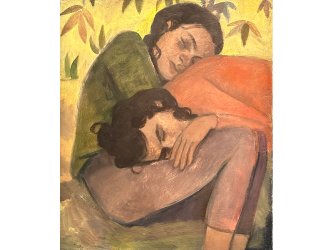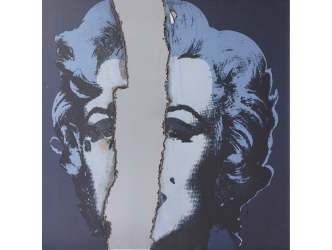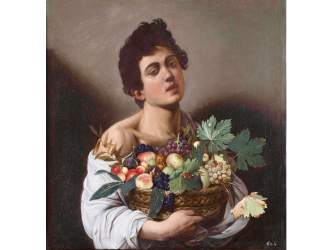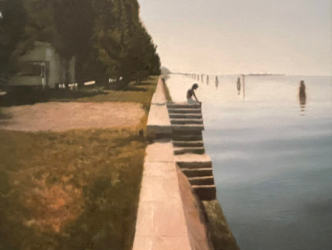The setting is sensational: FIAC, which takes place from 20 to 23 October, is swelled with 186 galleries from 26 different countries and this year stretches beyond the Grand Palais into the Petit Palais (where 4o works are shown inside and out at the front). The main road between the two buildings, Avenue Winston Churchill, has been pedestrianized especially for the occasion like it was in 1900 when the two buildings were first erected. Never has the city of Paris contributed so much to the magnificence of this event.
Jennifer Flay, the fair’s director, wants to stand strong against the misfortunes that Paris has suffered in recent months: ‘Our role is to be defiant in the face of the challenges. FIAC is a strong fair, but nothing can ever be certain. All our plans, such as pedestrianizing Avenue Winston Churchill, are designed under the watchful eye of the police headquarters.’
And she adds about the new FIAC:
In fact, across Paris, art professionals are redoubling their efforts this year to deliver stunning exhibitions in their spaces while the fair is in town. The design specialist Patrick Seguin has invited New York-based gallery Karma into his large space in Bastille. This art book publisher is displaying nearly 200 works on paper that start from 500 euros and go up to several hundred thousand. These include works by some fairly prominent painters and sculptors, from a etching by Manet of the famous Olympia offering her body on a sofa to an aquarelle by the American painter John Currin (born 1962). What do they all have in common? They’re all erotic scenes.
Thaddaeus Ropac is showing in his Marais space and at FIAC the work of Robert Rauschenberg (1925-2008) from ’84-’85 (on sale for between $550,000 and $4 million) as well as an ultra-rare item that was part of Rauschenberg’s personal collection: the famous Marcel Duchamp bottle rack that was remade in 1958. It is one of the archetypes for the ‘ready-made’. Only one museum will be able to purchase it. Thaddeus Ropac is not revealing the exact price but can confirm that it will top the record 8.9 million euros paid in 2009.
This year the FIAC management has killed off its satellite fair, Off, which took place for two years in the 13th arrondissement and was dedicated to younger galleries. It’s not entirely a bad thing: the work displayed there was uneven and the venue was unattractive and hard to get to.
If what you expect from a fair is a broad international spectrum and a relatively large showing of interesting works, then FIAC’s 2016 vintage is excellent, even if it’s just to wonder around like you would in a museum.
Pace Gallery, for instance, one of the historic American galleries run by Arne Glimcher, has several upmarket pieces on its stands.
We can start by mentioning the two-metre-long mobile by the American artist Calder on sale for $15 million, as well as the painting by Jean Dubuffet (1901-1985) from 1974 offered at $2 million.
When we asked the dealer his opinion of the French painter he answered: ‘If you can buy a key painting by Dubuffet for the price of a third-rate Andy Warhol drawing, it clearly goes to show that he is still under-valued.’
In New York, the Morgan Library has just inaugurated an exhibition of drawings by Dubuffet from ’35-’62 which should remind people of the importance of this artist from across the pond.
Arne Glimcher remains ambivalent about fairs, comparing them to a ‘carnival because they are designed as entertainment and contribute to the death of art’ but he himself exhibits because ‘nowadays collectors go more readily to fairs than galleries.’
He gives his recipe for a good stand:
This year, the most outstanding stand goes to the Londoner Sadie Coles with a space primarily filled with digitally enhanced self-portraits by the New York-based Swiss artist Urs Fischer, who I posted about last week. (https://judithbenhamouhuet.com/report/urs-fischer-a-fantastic-new-show-from-the-art-collectors-favourite-in-arles/).
He had also created iron zigzag lines, which are like childish doodles crossing out all the space.
The most interesting one-man show at the fair is on the first floor of the Grand Palais. Here the Parisian gallerist Christophe Gaillard is showing the work of Tetsumi Kudo (1935-1990), a Japanese artist who lived in Paris and is best known for his fanciful installations made of bits of human organs and artificial vegetation. According to Christophe Gaillard the prices for Kudo have multiplied ten-fold over the past decade and those on his stand go from 180,000 euros to 280,000 euros. Two influential galleries have recently organised exhibitions by the Japanese artist, Andrea Rosen in New York, who has a Kudo work selling at FIAC for $250,000 and the multinational gallery Hauser & Wirth, conspicuous by its absence at this year’s fair.
Not all prices in the contemporary art market have gone up. Far from it. The New York dealer Per Skarstedt is showing a ‘Spiritual America V’ on his stand.
It’s a well-known photo from 2005 by the famous American artist Richard Prince (born 1949) that plays as usual with stereotypes. It shows the actress Brooke Shields posing in a bikini and treated like a sidekick to the motorbike next to her. The 227 x180cm image can be acquired for $3.5 million ‘or half its asking price three years ago,’ underlines Skarstedt.
The contemporary art market is extremely prone to the vagaries of fashion. But it remains a domain in which colossal sums of money are invested, as indicated by the level of prices at stake at FIAC.




